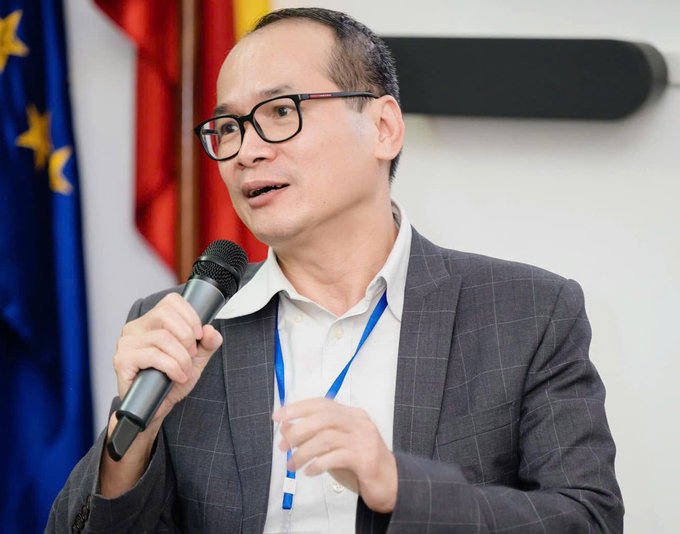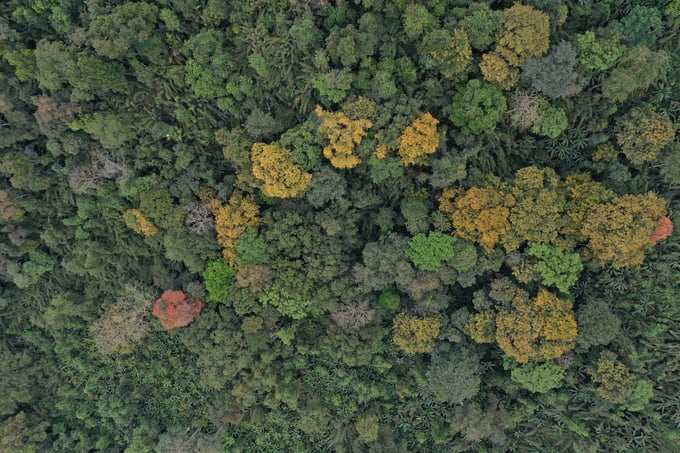November 26, 2025 | 03:43 GMT +7
November 26, 2025 | 03:43 GMT +7
Hotline: 0913.378.918
November 26, 2025 | 03:43 GMT +7
Hotline: 0913.378.918
The carbon credit market is becoming a potential sector not only globally but also in Vietnam, especially as the government is pushing to establish and pilot a carbon credit trading platform starting in 2025, with full implementation set for 2028.
In this context, the commercialization of carbon credits from forests is attracting significant interest from localities and people engaged in forestry. This is because Vietnam has valuable forest resources, with an area of over 14.86 million hectares, and 25 million people directly or indirectly rely on forests for their livelihoods.
However, the issue that arises now is how to effectively harness and utilize the benefits of forest carbon credits to both generate economic value and ensure the protection of forest resources and sustainable development. The reporter from Vietnam Agriculture Newspaper had a discussion with Mr. Pham Hong Luong, Deputy Director of the Department of Forestry (Ministry of Agriculture and Rural Development) on this issue.

Mr. Pham Hong Luong, Deputy Director of the Forestry Department, stated that the implementation of forest carbon credit exchange and transfer currently brings many notable impacts. Photo: Ngoc Diep.
With the rich forest resources, how do you assess the potential for the commercialization of forest carbon credits in Vietnam, especially with the carbon credit exchange expected to be piloted in 2025?
Currently, Vietnam’s forest cover rate stands at 42.02%, equivalent to 14.8 million hectares, with approximately 10.1 million hectares of natural forests. This area has significant carbon storage and absorption potential.
According to scientists, the total amount of carbon Vietnam could trade, after fulfilling national commitments, is projected to exceed 165,000 tons of carbon by 2030.
At present, the Emission Reduction Payment Agreement (ERPA) for the North Central region covers six provinces: Nghe An, Thanh Hoa, Ha Tinh, Quang Binh, Quang Tri, and Thua Thien Hue. These are the first six provinces where the Ministry of Agriculture and Rural Development is directing the Department of Forestry to implement pilot programs in accordance with Decree No. 107/2022/ND-CP.
Additionally, the ERPA for the Central Highlands and South Central regions, covering 11 provinces, is expected to finalize negotiations and carbon credit transfers by 2025.
Thus, currently, only six provinces in the North Central region are involved in carbon credit exchanges, and Vietnam's untapped forest carbon credit potential remains substantial.
Could you elaborate on the role and significance of exchanging and transferring forest carbon credits for forest protection and development, particularly as Vietnam strengthens its emissions reduction commitments and moves towards sustainable development goals?
The exchange and transfer of forest carbon credits today have significant impacts. First, for forest owners, participating in this agreement helps enhance forest governance capacity, creating opportunities to access new methods and approaches, which in turn improves forest management practices.

To attract both domestic and foreign investors into the forest carbon credit business, the government needs to build appropriate mechanisms and policies. Photo: Ngoc Diep.
Secondly, in terms of raising community awareness, this agreement helps people better understand the benefits that forests provide. In addition to income from forest products, people can also create other sources of income through activities like trading and transferring emission reduction results, also known as income from non-timber forest products.
Thirdly, the implementation of this agreement also helps enhance the management capacity of forest owners, allowing them to access modern technologies for monitoring and supervising forest developments. These factors not only improve management efficiency but also encourage efforts to protect and sustainably develop forests. All these factors will contribute to laying a strong foundation for sustainable forest management, protection, and development in the future.
What are your views on the challenges in implementing and operating the forest carbon credit market in Vietnam?
The Forestry Law and the Environmental Protection Law are currently important framework laws that set basic regulations regarding forest carbon absorption and storage services. However, to implement them effectively, we need detailed regulations in the form of decrees, covering important issues such as: carbon ownership rights, standards for carbon, regulations on certification organizations, and verification of emission reduction results.
Additionally, there needs to be clear regulations regarding the registration process and the development of forest carbon credit projects, as well as monitoring and evaluation procedures for implementation results. These regulations will ensure transparency and effectiveness in forest carbon credit activities.
In the near future, we need to continue improving these regulations, based on the pilot program in the North Central region. After reviewing and evaluating the results, the decrees will be adjusted and further detailed to create a solid legal foundation for developing the forest carbon credit market in Vietnam.
To effectively commercialize forest carbon credits, what specific solutions should localities focus on?
One of the important principles in exchanging or transferring emission reduction results or investing in forest carbon credits is demonstrating efforts to increase carbon absorption. This means that, under normal natural conditions, without any interventions, the carbon storage and absorption capacity of forests will not change.
However, when additional efforts and investments are made to improve forest development and manage forests more sustainably, the increase in carbon absorption will be verified and recognized by certifying organizations, and only then can it be considered carbon credits. This emphasizes that it cannot be simply assumed that forests automatically generate carbon credits. Instead, additional efforts to enhance forest management and development efficiency are essential.
Additionally, to exchange carbon credits, forest owners must develop a forest carbon credit investment project. This is a prerequisite for forest owners to proceed with subsequent steps in the process of transferring or trading carbon credits.
So, how can we attract more organizations, units, and forest owners to participate in the forest carbon credit business, especially in a market that is still emerging and where potential has not yet been fully exploited?
To attract domestic and foreign investors into the forest carbon credit business, I believe the government needs to build appropriate mechanisms and policies. Specifically, for businesses investing in technology development, incentive policies such as tax reductions, green credit programs, and other forms of support will play a key role in encouraging investment in this sector.

The forest can only be protected and developed well enough to measure the increased amount of carbon absorbed, from which carbon credits can be implemented. Photo: Ngoc Diep.
Regarding forest owners, this is the only sector in forestry that can absorb carbon and potentially develop into a business, including buying and selling carbon credits. However, to carry out these transactions, the fundamental element is the implementation of management, protection, and sustainable forest development measures. Only when forests are well protected and developed can we measure the increase in absorbed carbon and, from there, proceed with carbon crediting.
In forestry, to achieve emission reduction goals, there are seven important measures, including: protecting natural forests, restoring forests, developing forests, and implementing agroforestry methods. These measures not only help increase carbon absorption capacity but also contribute to environmental protection and long-term sustainable forest development.
In your opinion, what specific policies should be in place to establish and quickly form a forest carbon credit market, ensuring that the commercialization of carbon credits is more favorable and effective in the near future?
Currently, the Ministry of Agriculture and Rural Development (MARD) is continuing to improve regulations and technical guidelines. In fact, MARD has issued a Circular guiding measurement and inventory in the forestry sector. However, to achieve higher effectiveness, higher-level regulations, such as government decrees, are essential.
A positive signal is that the Ministry of Natural Resources and Environment is proposing to amend and supplement Decree 06 on ozone layer protection and greenhouse gas emissions reduction. At the same time, the Ministry of Finance has also been tasked by the Prime Minister to develop a plan to establish and develop a carbon market.
These are major policies and directions that help create favorable conditions for improving the system of legal documents and technical guidelines.
We hope that regulations from laws, decrees, circulars, and technical guidelines will create a complete and comprehensive legal framework. This will enable forest owners and forest-dependent communities to seize opportunities to increase income by transferring emission reduction results and buying and selling forest carbon credits. These are truly very positive signals in the current context.
Thank you!
Translated by Kieu Chi

(VAN) Deputy Minister Nguyen Quoc Tri emphasized the determination to prevent violations at CoP20, sharing enforcement results and commitments to strengthen cooperation with the international community in the coming period.

(VAN) In addition to strengthening the relationship between schools and enterprises, the Aus4Skills project expands opportunities for female students and people with disabilities to work in the transport and logistics sector.

(VAN) Nghe An is preparing policy, technical, and resource steps to participate in the forest carbon credit market.
/2025/11/25/1648-2-110733_532.jpg)
(VAN) From 2011 to 2023, Ca Mau province lost approximately 6,200 ha of coastal land and protection forests due to erosion, threatening many residential areas, infrastructure facilities, and production zones.

(VAN) Quang Ngai holds strong potential for carbon credits but needs a clear legal and policy framework to secure sustainable revenue from this resource.

(VAN) With its diverse ecosystem, Phu Quoc National Park plays a vital role in environmental protection and biodiversity conservation and serves as the core zone of the Kien Giang World Biosphere Reserve.

(VAN) Cooperation activities under the Aus4Skills program focus on: logistics professional development, competency-based training and assessment (CBTA), leadership innovation, and digitalization.